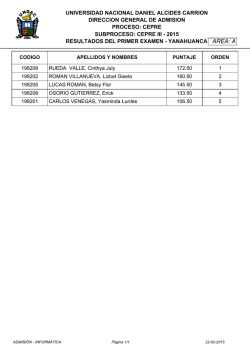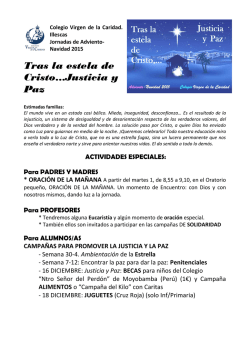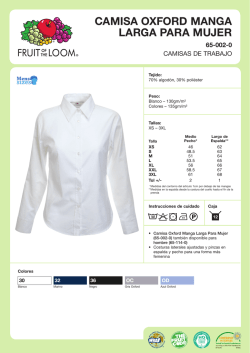
Los bajos fondos en Roma
LA INSEGURIDAD EN LA ANTIGUA ROMA: CRIMEN, VIOLENCIA Y DISTURBIOS por Hélène Ménard Krause, H.-U. (2004), Kriminalgeschichte der Antike, München, C.H. Beck, 2004. Lintott, A. (2004): Violence in republican Rome. Oxford: Oxford University Press (2a ed. [1a ed. 1968]). Ménard, H. (2000): “L’insécurité de la Rome impériale : entre réalité et imaginaire”, Histoire urbaine 2000, 2, pp. 59-71 (http://www.cairn.info/revue-histoire-urbaine-2000-2-page-59.htm). Nippel, W. (2010): Public order in Ancient Rome. Cambridge: Cambridge University Press, (1a ed. 1982). Reuter, M.; Schiavone, R. (eds. 2011): Gefährliches Pflaster. Kriminalität im römischen Reich, Xantener Berichte, 21. Mainz am Rhein: Verlag Philipp von Zabern. Salles, C. (2004): Les bas-fonds de l’Antiquité. Paris: Payot (1a ed. 1982). CALLEJEROS. LA CIRCULACIÓN Y LA VIDA A PIE DE CALLE EN LA CAPITAL por Ray Laurence Crawford, M. (1996): Roman Statutes, London: University of London. Hartnett, J. (2008a): “Si quis hic sederit: Streetside Benches and Urban Society in Pompeii”, American Journal of Archaeology, 112, pp. 91-119. Hartnett, J. (2008b): “Fountains at Herculaneum: Sacred History, Topography, and Civic Identity”, Rivista di Studi Pompeiani, 19, pp. 77-89. Laurence, R. (1999): The Roads of Roman Italy: Mobility and Cultural Change. London: Routledge. Laurence, R. (2008): “City Traffic and the Archaeology of Roman Streets”, en Mertens, D. (ed.) Stadtverkehr in der Antiken Welt/Traffico Urbano nel Mondo Antico (Palilia, 13), pp. 87-106. Laurence, R. (2013): “Roads and Bridges”, en DeRose Evans, J. (ed.) A Companion to the Archaeology of the Roman Republic, Oxford: Wiley-Blackwell, pp.296-308. Laurence, R. (2013): “Traffic and Land Transportation in and near Rome”, en Erdkamp, P. (ed) The Cambridge Companion to the City of Rome, Cambridge: Cambridge University Press. Laurence, R. (2014): “Streets and Facades”, en Ulrich R.B.; Quenemoen, C.K. (eds) A Companion to Roman Architecture, Oxford: Wiley-Blackwell, pp.399-411. Laurence, R.; Newsome, D. (2011): Rome, Ostia and Pompeii: Movement and Space. Oxford: Oxford University Press. Newbold, R.F. (1974): “Some Social and Economic Consequences of the AD 64 Fire at Rome”, Latomus, 33, pp. 858-69 Poehler, E. (2006): “The Circulation of Traffic in Pompeii’s Regio VI”, Journal of Roman Archaeology, 19, pp. 53-74. Raepsaet, G. (2008): “Land Transport, Part 2: riding, Harnesses, and Vehicles”, en Oleson, J.P. (ed) The Oxford Handbook of Engineering and Technology in the Classical World. Oxford: Oxford University Press, pp. 580-605. Ramage, E.S. (1984): “Urban Problems in Ancient Rome”, en Marchese, R.T. (ed.) Aspects of Graeco-Roman Urbanism: Essays on the Classical City. Oxford: BAR International Series, 188. Robinson, O. (1992): Ancient Rome. City Planning and Administration. London: Routledge. Scobie, A. (1986): “Slums, Sanitation and Mortality in the Roman World”, Klio, 68, pp. 399-433. Tilburg, van, C. (2007): Traffic and Congestion in the Roman Empire. London: Routledge. Yavetz, Z. (1965): “Plebs Sordida”, Athenaeum, 43, pp. 295-311. CONTROL POLICIAL, REPRESIÓN Y SEGURIDAD PRIVADA EN LA CIUDAD DE ROMA por Benjamin Kelly Bingham, S. (1999): “Security at the Games in the Early Imperial Period,” Echos du Monde Classique / Classical Views, No. 18, 369-379. Bingham, S. (2013): The Praetorian Guard: A History of Rome’s Elite Special Forces. Waco, Texas. Busch, A. W. (2011): Militär im Rom: Militärische und paramilitärische Einheiten im kaiserzeitlichen Stadtbild. Wiesbaden. Cascione, C. (1999): Tresviri capitales. Storia di una magistratura minore. Napoli. Coleman, K. (1990): “Fatal Charades: Roman Executions Staged as Mythological Enactments,” The Journal of Roman Studies, 80, pp. 44-73. Coulston, J. C. N. (2000): “ ‘Armed and Belted Men’: The Soldiery in Imperial Rome,” in J. C. N. Coulston and H. Dodge (eds.), Ancient Rome: The Archaeology of the Eternal City. Oxford, pp. 76-118. Crawford, M. H. (ed.) (1996): Roman Statutes. London. 2 volumes. Durry, M. (1938): Les cohortes prétoriennes. Paris. Echols, E. (1958): “The Roman City Police: Origin and Development,” Classical Journal, 53, pp. 377-84. Freis, H. (1967): Die Cohortes Urbanae. Köln and Graz. Fuhrmann, C. J. (2011): Policing the Roman Empire: Soldiers, Administration, and Public Order. New York. Garnsey, P. D. A. (1970): Social Status and Legal Privilege in the Roman Empire. Oxford. Harries, J. (2007): Law and Crime in the Roman World. Cambridge. Hirschfeld, O. 1913 [1891]. “Die Sicherheitspolizei im römischen Kaiserreich,” in his Kleine Schriften. Berlin, pp. 576612 Kelly, B. (2007): “Riot Control and Imperial Ideology in the Roman Empire”, Phoenix, 61, pp. 150-76. Kelly, B. (2013): “Policing and Security”, in P. Erdkamp (ed.), The Cambridge Companion to Ancient Rome. Cambridge, pp. 410-24. Kelly, B. (2014): “Crime, Law, and Order”, in M. Gibbs, M. Nikolic, and P. Ripat (eds.), Themes in Roman Society and Culture: An Introduction to Ancient Rome. Toronto, pp. 241-62. Kelly, J. M. (1966): Roman Litigation. Oxford. Krause, J.-U. (2004): Kriminalgeschichte der Antike. München. Lintott, A. W. (1999): The Constitution of the Roman Republic. Oxford. Lintott, A. W. (1999): Violence in Republican Rome. Oxford, 2nd edition. Mantovani, D. (1988): “Sulla competenza penale del praefectus urbi attraverso il Liber Singularis di Ulpiano,” in A. Burdese (ed.), Idee vecchie e nuove sul diritto criminale romano. Padova, pp. 171-223. Ménard, H. (2004): Maintenir l’ordre à Rome: IIe-IVe siècles ap. J.-C. Seyssel. Menéndez Argüín, A. R. (2006): Pretorianos. La guardia imperial de la antigua Roma. Madrid. Menéndez Argüín, A. R. (2010): “La guardia pretoriana en combate. I: equipamento,” Habis, No. 41, pp. 241-261. (Online at http://institucional.us.es/revistas/habis/41/art_15.pdf) Menéndez Argüín, A. R. (2011): “La guardia pretoriana en combate. II: rutinas de entrenamiento, operaciones, tácticas y despliegues,” Habis, No. 42, pp. 229-252. (Online at http://institucional.us.es/revistas/habis/42/art_10.pdf) Nippel, W. (1984): “Policing Rome”, Journal of Roman Studies, No. 74, pp. 20-9. Nippel, W. (1988): Aufruhr und “Polizei” in der römischen Republik. Stuttgart. Nippel, W. (1995): Public Order in Ancient Rome. Cambridge. Panciera, S. (1993): “Soldati e civili a Roma nei primi tre secoli dell’impero,” in W. Eck (ed.) Prosopographie und Sozialgeschichte. Köln, Wien, and Weimar, pp. 261-76. Passerini, A. (1939): Le coorti pretorie. Roma. Rainbird, J. S. (1986): “The Fire Stations of Imperial Rome,” Proceedings of the British School at Rome, 54, pp. 147-69. Robinson, O. F. (1992): Ancient Rome: City Planning and Administration. London and New York. Robinson, O. F. (1995): The Criminal Law of Ancient Rome. Baltimore, Md. Sablayrolles, R. (1997): “Sparteoli, les vigiles dans Rome,” in A. Lemémorel (ed.), La rue, lieu de sociabilité? Rouen, pp. 97-104. Sablayrolles, R. (1996): Libertinus miles: Les Cohortes de vigiles. Roma. LA VOZ DEL PUEBLO. CLASES BAJAS Y VIOLENCIA POLÍTICAMENTE MOTIVADA EN LAS CALLES DE ROMA por Gregory Aldrete Aldrete, G. (2013): “Riots,” en Erdkamp, P. (ed.) The Cambridge Companion to Ancient Rome, pp. 425-440. Cambridge: Cambridge University Press. Lintott, A. (1999): Violence in Republican Rome. 2ª ed. New York: Oxford University Press. Ménard, H. (2004): Maintenir l’Ordre à Rome (IIe-IVe Siècles AP. J.-C.). Paris: Champ Vallon. Mouritsen, H. (2001): Plebs and Politics in the Late Roman Republic. New York: Cambridge University Press. Tatum, J. (1999): The Patrician Tribune: Publius Clodius Pulcher. Chapel Hill: University of North Carolina Press. Vanderbroeck, P. (1987): Popular Leadership and Collective Behavior in the Late Roman Republic. Amsterdam: Gieben. Yavetz, Z. (1988): Plebs and Princeps. New Brunswick, N. J.: Transaction Books INFAMES Y FAMOSOS. LA SEDUCCIÓN DEL MUNDO DEL ESPECTÁCULO EN ROMA por David Vivó Christensen, P.; Kyle, D.G. (eds.) (2014): A Companion to Sport and Spectacle in Greek and Roman Antiquity. Blackwell companions to the ancient world. Oxford:Chichester. Edwards, C. (1993): The Politics of Immorality in ancient Rome. Cambridge: Cambridge University Press. Edwards, C. (1997): “Unspeakable professions: Public performance and prostitution in Ancient Rome”, en Hallet,J.P.; Skinner,M.B. (eds.) Roman Sexualities, pp. 66-95. Princeton-New Jersey. Futrell, A. (2006): The Roman Games. A Sourcebook, Oxford: Chichester. Knapp, R. (2011): Prostitutes, outlaws, slaves, gladiators, ordinary men and Women. The Romans that history forgot. London: Profile books. Kyle, D.G. (1998): Spectacles of death in ancient Rome. London-New York: Routledge. CAMAS DE OBRA. EL NEGOCIO DEL SEXO EN POMPEYA por Joaquín Ruiz de Arbulo Charbonnier, C. (1969): “La courtisane de Plaute à Ovide”, BAGB, pp. 451-550. CIL IV = Corpus Inscriptionum Latinarum (1871) : Vol. IV. Inscriptiones parietariae Pompeianae, Herculanenses, Stabianae, (ed.) Zangemeister, C. Berlín. CIL IV Suppl. = Corpus Inscriptionum Latinarum (1909): Vol IV. Supplementum. Inscriptionum parietariarum Pompeianorum, (ed.) Mau, A.; Zangemesiter, C. Berlín. Della Corte, M. (1965): Case e abitanti di Pompei, Nápoles. Guzzo, P.G.; Scarano Ussani, V. (2009): Ex corpore lucrum facere. La prostituzione nell’antica Pompei. Roma: L’Erma di Bretschneider. McGinn, T.A.J. (1998): Prostitution, sexuality and the Law in Ancient Rome. New York / Oxford. McGinn, T.A.J. (2004): The economy of prostitution in the Roman world. A study of social history and the Brothel. Ann Arbor: Univ. of Michigan. Puccini-Delbey, G. (2007): La vie sexuelle à Rome. Paris: Tallandier. Robert, J.-N. (1997): Eros Romain. Sexe et morale dans l’ancienne Rome. París: Les Belles Lettres. Stumpp, B.E. (1998): Prostitution in der römischen Antike. Berlin: Akademie verlag. Varone, A. (1994): Erotica pompeiana. Love inscriptions on the walls of Pompei. Roma. VIVIR EN LOS BAJOS FONDOS DE LA URBS. MITOS Y REALIDADES por Cyril Courrier y Jean-Pierre Guilhembet Courrier C. (2014): La Plèbe de Rome et sa culture. Rome: École française de Rome. Laurence R. (1997): “Writing the Roman metropolis”, en H. M. Parkins (dir.) Roman Urbanism. Beyond the Consumer City. Londres-New York, pp. 1-19. Lo Cascio E. (2001): “La population”, Pallas, 55, pp. 179-198. Salles C. (1982): Les bas-fonds de l’Antiquité. Paris: Éd. Robert Laffont. Scheidel W. (2003): “Germs for Rome”, en C. Edwards; G. Woolf (dir.), Rome the cosmopolis. Cambridge, pp. 158-176. Scobie A. (1986): “Slums, Sanitation, and Mortality in the Roman World”, Klio, 68, pp. 399-433. DE TESOROS HUNDIDOS A DOCUMENTOS HISTÓRICOS por Xavier Nieto Maarleveld, T.; Guérin, U.; Egger, B. (2013) (eds.): Manual para actividades dirigidas al Patrimonio Cultural Subacuático. París: UNESCO. Nieto, X.; Bethencourt, M. (2015) (coords.): Arqueología subacuática española. Cádiz: Universidad de Cádiz. Nieto, X.; Cau, M.A. (2009) (eds.): Arqueologia Nàutica Mediterrània. Girona: Monografies del CASC, 8. VV.AA. (2010): Libro Verde. Plan Nacional de Protección del Patrimonio Cultural Subacuático Español. Madrid: Ministerio de Cultura. Versión digital en: http://museoarqua.mcu.es/web/uploads/ficheros/verde_ingles.pdf
© Copyright 2025



